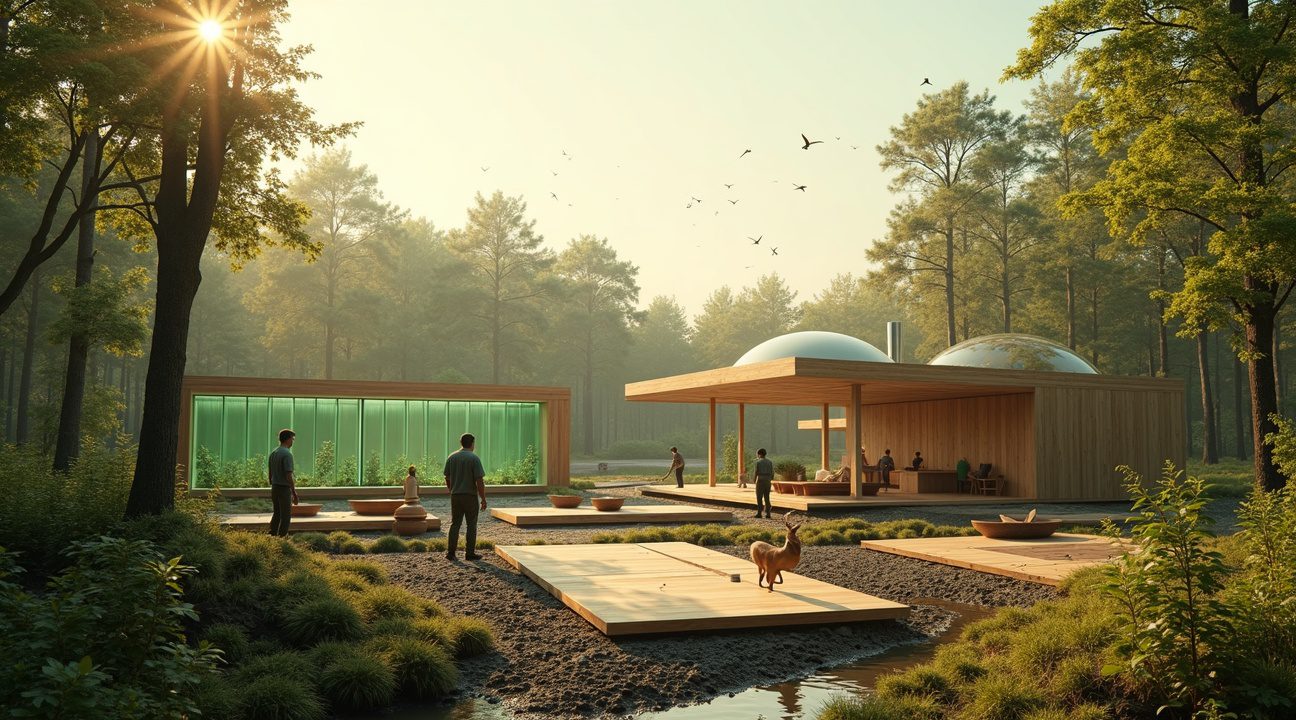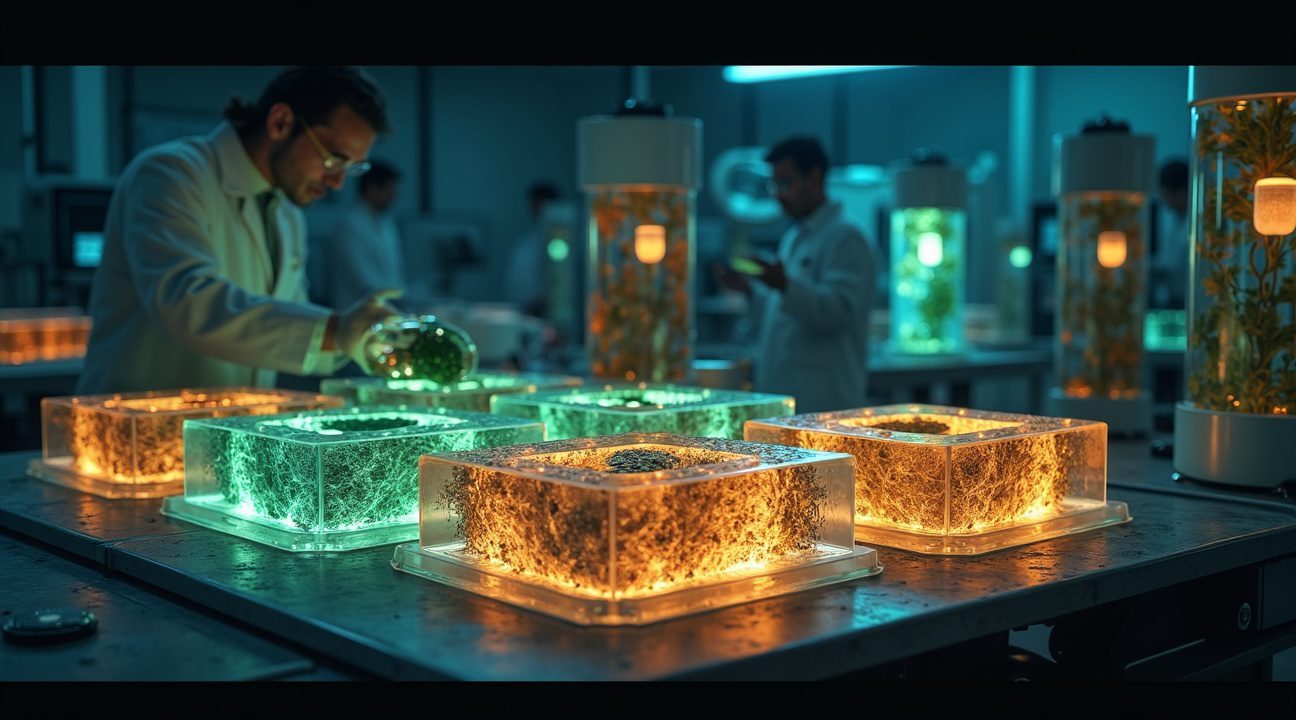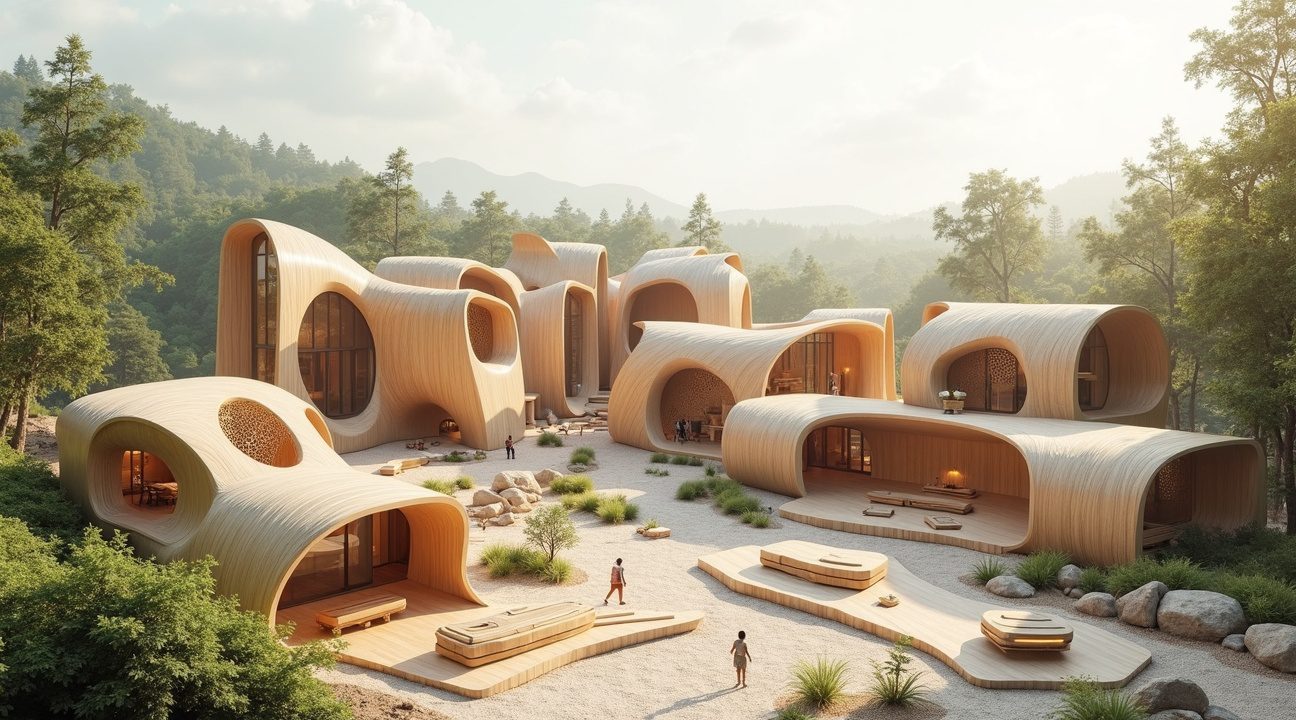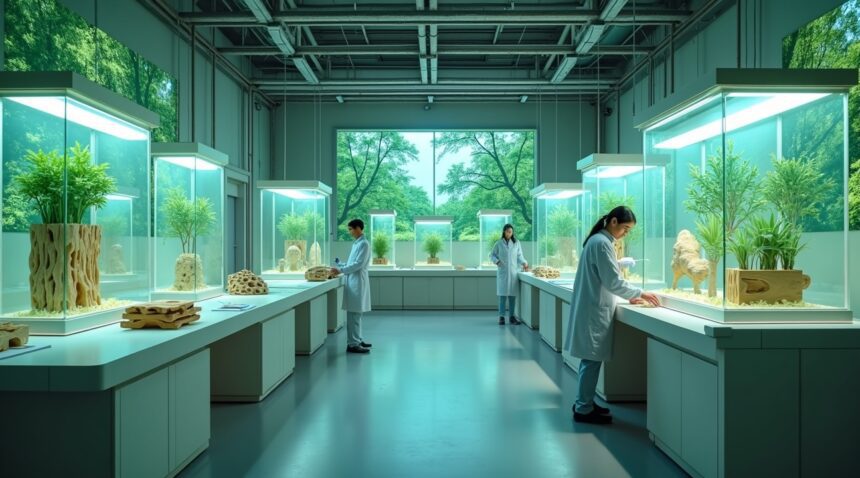MIT scientists have introduced a groundbreaking advancement in sustainable material production by developing a method to grow wood-like material in laboratories from plant cells—without felling a single tree.
Key Takeaways
- Lab-grown wood is ready in just three months, dramatically reducing the typical decades-long timber growth cycle and accelerating construction timelines nearly 100-fold.
- Customizable wood properties like density, strength, fire resistance, and moisture control can be achieved through the manipulation of hormone levels during growth.
- 3D bioprinting allows intricate geometries and shapes previously impossible using traditional woodworking methods.
- This innovation offers a zero-deforestation solution, helping reduce the loss of 10 million hectares of forest every year while maintaining timber availability.
- Precision manufacturing minimizes waste by producing exact components without traditional offcuts or surplus material.
From Plant Cells to Timber in Months
The process begins with zinnia plant cells, which are cultured in a highly controlled environment. These cells are guided via hormones and growth factors to form materials structurally similar to traditional wood. By compressing what nature takes decades to do into just three months, the process offers speedy access to usable, wood-like materials.
Unprecedented Control Over Material Properties
One of the most innovative aspects is the ability to engineer specific wood characteristics. By altering hormone concentrations during cell development, researchers can fine-tune properties such as:
- Material density and strength
- Fire resistance levels
- Water and moisture resilience
This enables industries to design wood tailored for particular functions, unlike traditional reliance on what natural forests provide.
Embracing the Power of 3D Bioprinting
Laboratory-grown wood also benefits from the integration of 3D bioprinting technology. Engineers can fabricate detailed internal geometries, hollow areas, and design elements unable to be carved or cut by traditional machines. This includes built-in channels for wiring, joint-ready connectors, and stress-optimized designs.
Significant Environmental Impact
Besides preserving forests, lab-grown wood supports environmental sustainability by:
- Reducing emissions from heavy logging equipment and long-distance timber transportation
- Minimizing waste, as every part of the lab-grown wood is produced to specification—unlike traditional lumber where only 40–60% is usable
- Lowering energy consumption by consolidating production in localized, controlled environments
Improved Quality Control and Global Accessibility
Another key benefit is consistency. Traditional lumber varies based on growing conditions, location, and tree species genetics. In contrast, lab-grown wood is produced under monitored conditions, delivering standard properties across batches.
This consistency allows countries with limited forest resources to produce quality wood locally. It removes dependencies on importation and seasonal cycles, boosting global self-sufficiency and supporting sustainable production practices.
Flexibility and Scalability for Industries
Manufacturers can respond to market demand without the restriction of forestry cycles. Notably, the technology provides flexibility to:
- Adjust production volumes rapidly
- Develop entirely new wood types by blending physical traits and textures of multiple species
- Replicate endangered wood species without environmental repercussions
Seamless Integration With Existing Tools
Lab-grown wood behaves similarly to naturally harvested timber in machining, painting, joining, and handling. This means that industries and construction professionals can adopt the material with minimal workflow interruption.
A Path Toward Sustainable Innovation
Looking ahead, researchers are exploring the integration of other plant cell types to produce hybrid materials with built-in natural preservatives or fiber reinforcements. These advancements may unlock new frontiers for construction, packaging, and manufacturing applications.
Ultimately, this revolutionary technique doesn’t just refine how we obtain timber—it redefines the relationship between construction materials and ecological responsibility. It paves a path for sustainable growth that aligns with both industrial needs and long-term environmental goals.
Lab-Grown Wood Creates Customizable Timber in Just Three Months Without Felling a Single Tree
MIT scientists have achieved what once seemed impossible: creating authentic wood-like material in a controlled laboratory environment without cutting down a single tree. This groundbreaking technique transforms how I think about sustainable construction materials, offering a solution that could revolutionize both the timber industry and environmental conservation efforts.
The speed of this process represents perhaps its most striking advantage. While traditional timber requires decades to mature into usable material, lab-grown wood reaches completion in just three months. This acceleration factor of nearly 100 times faster than natural growth cycles means construction projects won’t need to wait for forests to regenerate, fundamentally changing project timelines and resource planning.
Precision-Engineered Properties for Specific Applications
Unlike natural wood that grows with inherent variations and limitations, synthetic lumber offers unprecedented control over its characteristics. Scientists can adjust the material’s density, strength, and thermal properties to match exact specifications. This precision engineering means builders can order timber with specific structural capabilities for load-bearing applications or enhanced insulation properties for energy-efficient construction.
The customization extends beyond basic mechanical properties. Lab-grown wood can be fine-tuned for moisture resistance, fire retardancy, or even specific aesthetic qualities. This level of control eliminates the guesswork traditionally associated with natural timber selection, where builders must work around the wood’s existing properties rather than designing material to meet their needs.
Revolutionary 3D Bioprinting Applications
Perhaps the most innovative aspect involves 3D bioprinting capabilities that allow direct creation of furniture and construction components. This process eliminates traditional woodworking steps like cutting, shaping, and joining pieces together. Manufacturers can bioprint complex geometries and intricate designs that would be impossible or extremely costly to achieve with conventional timber.
The implications extend far beyond simple convenience. Advanced manufacturing techniques like these reduce material waste to nearly zero, as each component gets printed to exact specifications without excess material. Construction companies can produce custom architectural elements, furniture pieces, or structural components directly from digital designs, streamlining the entire production process.
This zero deforestation approach addresses one of the construction industry’s most pressing environmental challenges. Traditional timber harvesting contributes significantly to forest loss, but lab-grown alternatives could maintain forest ecosystems while still providing the wood products society needs. The technology represents a fundamental shift from extractive to regenerative manufacturing practices, creating sustainable materials that don’t compromise natural habitats or biodiversity.
Revolutionary 3D Bioprinting Process Transforms Plant Cells Into Wood-Like Material
The MIT team’s approach begins with extracting cells from Zinnia elegans leaves, a process that provides the foundation for creating wood without traditional harvesting methods. These isolated plant cells undergo cultivation in a nutrient-rich liquid medium for precisely two days, establishing the optimal cellular environment for subsequent transformation.
Following this initial phase, researchers transfer the cultured cells into a specialized gel-based medium. This medium contains carefully selected hormones and nutrients that direct cellular development away from leaf characteristics and push them to develop wood-like properties instead. The process mirrors techniques used in biomedical research where scientists manipulate stem cells, except here the focus is on plant cellular transformation.
Hormone Manipulation Controls Material Properties
Researchers discovered they can precisely control the final material’s characteristics by adjusting hormone concentrations within the gel medium.
- Higher concentrations of specific hormones produce denser material
- Different ratios create variations in stiffness and structural integrity
This level of control allows scientists to customize the wood-like material for specific applications, something impossible with traditional lumber.
The transformation occurs through lignification, a natural process where plant cells develop lignin — the compound that gives wood its strength and rigidity. By triggering this process in laboratory conditions, the team creates authentic wood properties without requiring trees to grow for decades.
After sufficient time in the hormone-enriched medium, the material becomes ready for the final step: 3D bioprinting. This technique enables creation of complex shapes and structures that natural wood simply cannot achieve.
Advantages of 3D Bioprinting with Lab-Grown Wood:
- Engineers can design custom forms and intricate internal geometries
- Structures can be tailored to specific dimensions
- Shapes that are impossible to cut from traditional lumber can be created
Testing reveals the final bioprinted material matches natural wood’s stiffness properties, making it suitable for structural applications. The lab-grown wood demonstrates comparable mechanical properties to conventional lumber, validating its potential as a sustainable alternative. This breakthrough offers possibilities for creating architectural elements, furniture components, and specialized shapes that traditional woodworking cannot produce.
The entire process eliminates the need for tree harvesting while maintaining wood’s essential characteristics. Unlike synthetic alternatives that often compromise on strength or environmental impact, this liquid medium approach produces genuine wood-like material through biological processes. The method represents a fundamental shift in how we might produce wood products, potentially reducing deforestation pressure while expanding design possibilities beyond what nature originally provided.
Environmental Impact: Combating Deforestation and Waste in Construction
The statistics surrounding forest loss paint a stark picture of our current environmental crisis. Each year, approximately 10 million hectares of forest disappear due to deforestation activities, creating devastating ripple effects across ecosystems worldwide. I find this lab-grown wood innovation particularly compelling because it directly addresses this massive environmental challenge by completely eliminating the need for tree harvesting.
Eliminating Deforestation Pressure
Lab-grown wood represents a revolutionary shift away from traditional forestry practices. Instead of cutting down centuries-old trees, scientists can now cultivate wood materials in controlled laboratory environments. This approach removes the pressure on natural forests, which currently face unprecedented threats from logging operations. The technology preserves critical habitats that house countless species while maintaining the carbon-storing capacity of existing forests.
Biodiversity loss becomes significantly less severe when forests remain intact. Wildlife corridors stay connected, allowing animal populations to thrive without fragmentation. Carbon emissions from deforestation activities also decrease substantially, contributing to improved climate stability. I believe this innovation could fundamentally transform how we think about essential building blocks for sustainable construction.
Reducing Manufacturing Waste
Traditional woodworking relies heavily on subtractive manufacturing processes that create enormous amounts of waste. Carpenters and manufacturers typically start with large timber pieces and cut them down into smaller components, discarding significant portions as unusable scraps. This wasteful approach contradicts sustainable manufacturing principles.
Lab-grown wood eliminates this inefficiency by producing materials in precisely the forms and dimensions required for specific applications. The following advantages emerge from this targeted production method:
- Zero material waste during the growing process
- Custom shapes and sizes grown to exact specifications
- Reduced transportation costs due to optimized dimensions
- Lower energy consumption compared to traditional processing
- Minimal packaging requirements for finished products
The construction industry’s environmental footprint shrinks considerably when manufacturers adopt this precision-based approach. I’ve observed how innovative technologies often create unexpected environmental benefits, and lab-grown wood exemplifies this trend perfectly.
Climate resilience improves when sustainable alternatives replace resource-intensive traditional materials. The global construction sector, responsible for consuming massive quantities of natural lumber, can now access environmentally responsible options without compromising quality or performance. This technological breakthrough offers hope for balancing human development needs with environmental protection requirements.

How Scientists Control Wood Properties Through Hormone Manipulation
Scientists at MIT discovered they can engineer wood properties by precisely controlling hormone concentrations in their growth medium. This breakthrough allows researchers to customize the final material’s characteristics without relying on traditional forestry methods.
Hormone-Driven Property Control
The key to controlling wood properties lies in manipulating hormone levels during the growth process. Low hormone concentrations produce softer, more porous structures that mimic the characteristics of certain softwoods. Conversely, high hormone levels trigger increased lignin development, resulting in stiffer, denser materials that resemble hardwood properties.
This hormonal control system operates through specific biochemical pathways that influence cell wall thickness and composition. Researchers adjust these concentrations based on the desired end-use application, whether that’s structural support or more flexible applications. The precision of this approach rivals what nature achieves over decades of tree growth.
The Complete Manufacturing Process
The production process begins with cell isolation from plant tissue, followed by cultivation in a carefully controlled liquid culture environment. Scientists then transfer these cultured cells into a specialized gel medium where the real magic happens.
The manufacturing stages include:
- Cell isolation from donor plant material
- Liquid culture development under controlled conditions
- 3D printing of the gel-embedded cells into desired shapes
- Three-month incubation period in complete darkness
- Dehydration to remove excess moisture
- Final finishing treatments to achieve desired surface properties
During the three-month incubation period, cells undergo rapid development in darkness, which stimulates accelerated growth patterns similar to those found in natural wood formation. This liquid transformation process allows for unprecedented control over the final material structure.
The dehydration phase proves critical for achieving mechanical properties comparable to conventional wood. Scientists carefully regulate moisture removal to prevent cracking while maintaining structural integrity. Final finishing treatments can include surface modifications that enhance durability or aesthetic appeal.
This controlled material engineering approach represents a significant advancement in sustainable manufacturing. By manipulating cellular development through hormone regulation, researchers create wood-like materials with predictable properties, eliminating the variability inherent in natural timber. The process produces materials that match or exceed conventional wood performance while requiring no tree harvesting whatsoever.
The precision available through this method opens possibilities for creating specialized wood products with properties specifically designed for particular applications, something impossible to achieve consistently through traditional forestry.

Future Applications and Revolutionary Potential for Construction Industry
I believe this breakthrough technology will fundamentally reshape how builders approach construction projects. Lab-grown wood offers unprecedented control over material properties, allowing scientists to engineer timber with enhanced strength characteristics or superior insulation capabilities tailored for specific applications.
Customizable Properties for Enhanced Performance
The ability to tune wood properties during the growth process creates opportunities that natural timber simply can’t match. Structural engineers can now specify wood with exact density requirements, moisture resistance levels, or thermal properties needed for particular building applications. This precision eliminates the guesswork traditionally associated with selecting natural lumber grades and reduces material waste on construction sites.
Furniture manufacturers will benefit from wood grown into complex geometries that would be impossible or extremely costly to achieve through traditional cutting and shaping methods. Load-bearing elements can be cultivated with internal structures optimized for stress distribution, while decorative components can incorporate intricate patterns formed during the cellular growth phase.
Environmental Benefits and Design Innovation
This technology addresses critical sustainability challenges facing the construction industry. By eliminating tree harvesting, lab-grown wood production significantly reduces carbon emissions associated with logging, transportation, and processing. Forest ecosystems remain intact, preserving biodiversity while still meeting global demand for wood products.
The manufacturing process enables entirely new design paradigms that weren’t previously feasible. Architects can specify building components with integrated features – such as channels for electrical wiring or embedded insulation properties – grown directly into the wood structure. This integration reduces assembly time and eliminates the need for additional materials.
Construction teams will appreciate the consistency and predictability of lab-grown wood compared to natural timber’s inherent variability. Each piece meets exact specifications without the knots, warping, or strength variations that characterize traditional lumber. This reliability streamlines project planning and reduces construction delays caused by material defects.
The technology also opens possibilities for creating wood products in regions where forests don’t naturally exist, reducing transportation costs and making sustainable building materials more accessible globally. As production scales up, this innovation could revolutionize sustainable building practices while maintaining the aesthetic and functional qualities that make wood such a valued construction material.

Current Challenges and Path to Commercial Viability
MIT’s groundbreaking wood biofabrication technology faces several hurdles before reaching commercial markets. The research team currently limits their work to cells from Zinnia elegans, a flowering plant that serves as their primary biological foundation. This narrow focus creates constraints that researchers must address before scaling operations.
Scaling Beyond Laboratory Conditions
The transition from laboratory success to industrial production presents significant challenges. Current biofabrication processes work effectively in controlled lab environments, but manufacturing wood at commercial volumes requires different approaches. Scaling up these techniques demands substantial investment in specialized equipment and facilities designed to handle larger cell cultures while maintaining the precise conditions necessary for wood formation.
Cost reduction becomes critical as production volumes increase. Laboratory-grade materials and processes carry premium price tags that make commercial viability difficult. The research team led by Ashley Beckwith and Luis Fernando Velásquez-García continues working to streamline their methods and identify more cost-effective alternatives without compromising quality.
Expanding Biological Diversity
Future commercial success depends on diversifying beyond Zinnia elegans cells. Different plant species offer varying wood characteristics, densities, and properties that could serve specific applications in construction and manufacturing. Scientists recognize the need to develop cultivation techniques for multiple plant varieties to create a broader range of lab-grown wood products.
The research team focuses on refining biofabrication techniques that can accommodate different cellular structures and growth patterns. This flexibility will allow manufacturers to produce specialized wood types for specific industries, from lightweight materials for furniture to dense, durable options for structural applications.
Market adoption in construction and manufacturing sectors requires wood products that meet established industry standards. Lab-grown alternatives must demonstrate comparable strength, durability, and workability to traditional timber. Achieving this consistency across different plant species represents one of the most significant technical challenges facing the research team.
The path forward involves continued investment in research and development while building partnerships with potential commercial users. Early adopters in sustainable construction and eco-friendly manufacturing may provide the market entry points necessary for broader acceptance. Meanwhile, the technological advances in other fields demonstrate how innovative solutions can transition from laboratory concepts to commercial reality through persistent development and strategic partnerships.
https://www.youtube.com/watch?v=0jjFVUkO4ze8VM
Sources:
MIT News: “Toward customizable timber, grown in a lab”
Popular Mechanics: “Lab-Grown Wood Could Save Your Next DIY”
Professional Engineering: “MIT’s lab-made ‘wood’ could grow into tables or other products”
IWF Atlanta: “Lab Grown 3D Printed Wood? MIT Says It’s Coming”
Wood Central: “How 3D-Printing is Being Used to Produce Tree-Free Wood”


